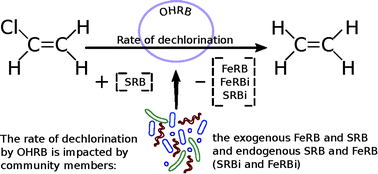Process understanding of microbial communities containing organohalide-respiring bacteria (OHRB) is important for effective bioremediation of chlorinated ethenes. The impact of iron and sulfate reduction on cis-1,2-dichloroethene (cDCE) and vinyl chloride (VC) dechlorination by a consortium containing the OHRB Dehalococcoides spp. was investigated using multiphase batch experiments. The OHRB consortium was found to contain endogenous iron- and sulfate-reducing bacteria (FeRB and SRB). A biogeochemical model was developed and used to quantify the mass transfer, aquatic geochemical, and microbial processes that occurred in the multiphase batch system. It was determined that the added SRB had the most significant impact on contaminant degradation. Addition of the SRB increased maximum specific substrate utilization rates, kmax, of cDCE and VC by 129% and 294%, respectively. The added FeRB had a slight stimulating effect on VC dechlorination when exogenous SRB were absent, but when cultured with the added SRB, FeRB moderated the SRB's stimulating effect. This study demonstrates that subsurface microbial community interactions are more complex than categorical, guild-based competition for resources such as electron donor.

